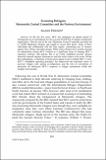| dc.contributor.author | Friesen, Aileen | |
| dc.date.accessioned | 2022-06-27T21:11:19Z | |
| dc.date.available | 2022-06-27T21:11:19Z | |
| dc.date.issued | 2022-07 | |
| dc.identifier.citation | Friesen, Aileen. "Screening Refugees: Mennonite Central Committee and the Postwar Environment," Mennonite Quarterly Review 96 (July 2022): 381-416. | en_US |
| dc.identifier.issn | 0025-9373 | |
| dc.identifier.uri | https://hdl.handle.net/10680/2003 | |
| dc.description | This article appears with the kind permission of the editor. | en_US |
| dc.description.abstract | In the last few years, MCC has undergone an intense period of introspection as it reconsidered its role as a post-World War II refugee resettlement organization. After the end of the war, Mennonite Central Committee provided aid to 12,000 Mennonite refugees and sought to secure their future. Some of these individuals had collaborated with the Nazi regime, committing acts of violence against Jews, Roma, and other groups. While some scholars have recently focused on antisemitism among MCC workers as a significant factor in shaping MCC’s responses, policies, and actions, this is an overly simplified account. Serious historical research requires historians to seek the wider context of an event. Within this methodology, a multitude of motivations appear to have molded MCC’s work. MCC’s Anabaptist operating principles, the improvised and emotional nature of post-war refugee work among co-religionists, and the role of conventions of patriarchy all influenced MCC’s response to refugee resettlement within this complex environment. | en_US |
| dc.description.uri | https://www.goshen.edu/mqr/ | en_US |
| dc.language.iso | en | en_US |
| dc.publisher | Goshen College, Goshen, Indiana | en_US |
| dc.rights | info:eu-repo/semantics/openAccess | en_US |
| dc.subject | Refugees: | en_US |
| dc.title | Screening Refugees: Mennonite Central Committee and the Postwar Environment | en_US |
| dc.type | Article | en_US |

